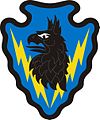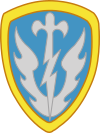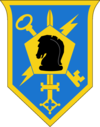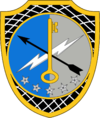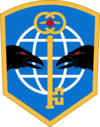| This article may rely excessively on sources too closely associated with the subject, potentially preventing the article from being verifiable and neutral. Please help improve it by replacing them with more appropriate citations to reliable, independent, third-party sources. (September 2022) (Learn how and when to remove this message) |
| Military Intelligence Corps | |
|---|---|
 Seal of the U.S. Army Military Intelligence Corps Seal of the U.S. Army Military Intelligence Corps | |
| Active | 1863–present |
| Country | |
| Branch | |
| Type | Military intelligence |
| Garrison/HQ | Fort Belvoir, VA |
| Motto(s) | Always Out Front |
| March | "MI Corps March" |
| Engagements | |
| Commanders | |
| Chief (USAICoE) | MG Richard T. Appelhans |
| Command Sergeant Major (USAICoE) | CSM Jesse M. Townsend |
| Chief Warrant Officer (USAICoE) | CW5 Peter Davis |
| Insignia | |
| Branch insignia |  |
| Regimental insignia |  |
| Branch plaque |  |
| Regimental coat of arms |  |
| Former branch insignia (1923–1962) |  |
| Former Army Security Branch Insignia (Army Reserve) (1954–1967) |  |
The Military Intelligence Corps is the intelligence branch of the United States Army. The primary mission of military intelligence in the U.S. Army is to provide timely, relevant, accurate, and synchronized intelligence and electronic warfare support to tactical, operational and strategic-level commanders. The Army's intelligence components produce intelligence both for Army use and for sharing across the national intelligence community.
History
Intelligence personnel were a part of the Continental Army since its initial founding in 1776.
In 1776, General George Washington commissioned the first intelligence unit. Knowlton's Rangers, named after its leader Colonel Thomas Knowlton, became the first organized elite force, a predecessor to modern special operations forces units such as the Army Rangers, Delta Force, and others. The "1776" on the United States Army Intelligence Service seal refers to the formation of Knowlton's Rangers.
In January 1863, Major General Joseph Hooker established the Bureau of Military Information for the Union Army during the Civil War, headed by George H. Sharpe. Allan Pinkerton and Lafayette C. Baker handled similar operations for their respective regional commanders. All of those operations were shut down at the end of the Civil War in 1865.
In 1885, the Army established the Military Intelligence Division. In 1903, it was placed under the new general staff in an elevated position.
In March 1942, the Military Intelligence Division was reorganized as the Military Intelligence Service. Originally consisting of just 26 people, 16 of them officers, it was quickly expanded to include 342 officers and 1,000 enlisted personnel and civilians. It was tasked with collecting, analyzing, and disseminating intelligence. Initially it included:
- an Administrative Group
- an Intelligence Group
- a Counter-intelligence Group
- an Operations Group
- a Language School
In May 1942, Alfred McCormack established the Special Branch of the Military Intelligence Service, which specialized in communications intelligence.
On 1 January 1942, the U.S. Army Corps of Intelligence Police, founded in World War I, was re-designated as the U.S. Army Counter Intelligence Corps. In 1945, the Special Branch became the Army Security Agency.
On June 19, 1942, the Military Intelligence Training Center at Camp Ritchie, Maryland, was formed. This group is now widely known as the Ritchie Boys and are credited with gathering over half of the actionable intelligence in the European Theatre. Most Ritchie Boys were fluent in European languages and could easily interrogate prisoners of war and civilians who knew vital information.
At its peak in early 1946, the MIS Language School had 160 instructors and 3,000 students studying in more than 125 classrooms, graduating more than 6,000 students by the end of the war. What began as an experimental military intelligence language-training program launched on a budget of $2,000 eventually became the forerunner of today's Defense Language Institute for the tens of thousands of linguists who serve American interests throughout the world.
The school moved to the Presidio of Monterey in 1946. Renamed the Army Language School, it expanded rapidly in 1947–48 during the Cold War. Instructors, including native speakers of more than thirty languages and dialects, were recruited from all over the world. Russian became the largest language program, followed by Chinese, Korean, and German.

On 1 September 1954, the Assistant Chief of Staff for Intelligence (ACSI) officially redesignated the CIC Center, Fort Holabird, Maryland, as the United States Army Intelligence Center, and the Chief of the Counter Intelligence Corps became its Commanding General. The following year, the Intelligence Center expanded further with the addition of the Photo Interpretation Center. Additionally, combat intelligence training (including order of battle techniques, photo interpretation, prisoner of war interrogation, and censorship) was transferred from the Army General School at Fort Riley, Kansas, to Fort Holabird, giving the commanding general the additional title of commandant, U.S. Army Intelligence School. This arrangement centralized nearly all intelligence training at the U.S. Army Intelligence Center and School, Fort Holabird.
The Intelligence Center and School remained at Fort Holabird until overcrowding during the Vietnam War forced its relocation to Fort Huachuca, Arizona. Fort Huachuca became the "Home of Military Intelligence" on 23 March 1971, and the last class graduated from Fort Holabird on 2 September 1971, almost 17 years to the day after the Army Intelligence Center was established there. USAINTCS Established at Fort. Holabird, MD
On 1 July 1962, the Army Intelligence and Security Branch was established as a basic Army branch to meet the increased need for national and tactical intelligence. The redesignated branch came with the creation of a new dagger and sun branch insignia, replacing the sphinx insignia that had been in place since 1923.
A number of intelligence and security organizations were combined in July 1967 to form the military intelligence branch. In 1977, they recombined with the Army Intelligence Agency and Army Security Agency to become the U.S. Army Intelligence and Security Command.
On 1 July 1987, the Military Intelligence Corps was activated as a regiment under the U.S. Army Regimental System. All United States Army Military Intelligence personnel are members of the Military Intelligence Corps.
Structure
Approximately 28,000 military personnel and 3,800 civilian personnel are assigned to intelligence duties, comprising the Military Intelligence Corps. Some of the key components include:
| Name | Insignia | Function | Garrison |
|---|---|---|---|
| Office of the Deputy Chief of Staff, Intelligence (G-2) | 
|
As the Army's Chief Intelligence Officer, the responsibilities of the Deputy Chief of Staff for Intelligence include policy formulation, planning, programming, budgeting, management, staff supervision, evaluation, and oversight for intelligence activities, as well as overall coordination of the major intelligence disciplines. | Fort Belvoir |
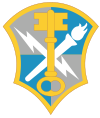
|
INSCOM is the U.S. Army's major intelligence command. | Fort Belvoir | |

|
MIRC is the U.S. Army Reserve's intelligence command. | Fort Belvoir | |

|
USAICoE is the U.S. Army's school for professional training of military intelligence personnel. | Fort Huachuca |
Major military intelligence units
Museum
The United States Army Intelligence Museum is located at Fort Huachuca, Arizona. It features the history of American military intelligence from the Revolutionary War to present. In the Army Military Intelligence Museum there is a painting of "The MI Blue Rose". The back of this painting indicates Sgt. Ralph R Abel, Jr. created it. The painting was photographed and distributed worldwide. Sgt. Abel also painted a replica of the corps flag.
Military Intelligence Hall of Fame
Main article: Military Intelligence Hall of FameList of Deputy Chiefs of Staff for Intelligence, G-2
The title of Deputy Chief of Staff for Intelligence, G-2 appeared in 1985. Prior to 1985, this office was known as Chief, Military Intelligence Division (1917–1920), Assistant Chief of Staff, G-2 (1920–1945, 1948–1985), and Director of Intelligence (1946–1948).
| No. | Deputy Chief of Staff | Term | |||
|---|---|---|---|---|---|
| Portrait | Name | Took office | Left office | Term length | |
| 1 |
 | Colonel Ralph H. Van Deman | June 1918 | August 1920 | ~2 years, 61 days |
| 2 |
 | Brigadier General Marlborough Churchill | June 1918 | August 1920 | ~2 years, 61 days |
| 3 |
 | Brigadier General Dennis E. Nolan | September 1920 | September 1921 | ~1 year, 0 days |
| 4 |
 | Brigadier General Stuart Heintzelman | September 1921 | November 1922 | ~1 year, 61 days |
| 5 |
 | Colonel William K. Naylor | November 1922 | June 1924 | ~1 year, 213 days |
| 6 |
 | Colonel James H. Reeves | July 1924 | April 1927 | ~2 years, 274 days |
| 7 |
 | Colonel Stanley H. Ford | May 1927 | September 1930 | ~3 years, 123 days |
| 8 |
 | Brigadier General Alfred T. Smith | January 1931 | January 1935 | ~4 years, 0 days |
| 9 |
 | Brigadier General Harry E. Knight | February 1935 | November 1935 | ~273 days |
| 10 |
 | Colonel Frances H. Lincoln | November 1935 | June 1937 | ~1 year, 212 days |
| 11 |
 | Colonel R. Warner McCabe | July 1937 | February 1940 | ~2 years, 215 days |
| 12 |
 | Brigadier General Sherman Miles | April 1940 | December 1941 | ~1 year, 244 days |
| 13 |
 | Brigadier General Raymond E. Lee | December 1941 | March 1942 | ~90 days |
| 14 |
 | Major General George V. Strong | May 1942 | February 1944 | ~1 year, 276 days |
| 15 |
 | Major General Clayton Bissell | February 1944 | January 1946 | ~1 year, 334 days |
| 16 |
 | Lieutenant General Hoyt Vandenberg | January 1946 | June 1946 | ~151 days |
| 17 |
 | Lieutenant General Stephen J. Chamberlin | June 1946 | October 1948 | ~2 years, 122 days |
| 18 |
 | Major General Stafford L. Irwin | November 1948 | August 1950 | ~1 year, 273 days |
| 19 |
 | Major General Alexander R. Bolling | August 1950 | August 1952 | ~2 years, 0 days |
| 20 |
 | Major General R. C. Partridge | August 1952 | November 1953 | ~3 years, 92 days |
| 21 |
 | Major General Arthur G. Trudeau | November 1953 | August 1955 | ~1 year, 273 days |
| 22 |
 | Major General Ridgely Gaither | August 1955 | July 1956 | ~335 days |
| 23 |
 | Major General Robert A. Schow | August 1956 | October 1958 | ~2 years, 61 days |
| 24 |
 | Major General John M. Willems | November 1958 | October 1961 | ~2 years, 334 days |
| 25 |
 | Major General Alva R. Fitch | October 1961 | January 1964 | ~2 years, 92 days |
| 26 |
 | Major General Edgar C. Doleman | January 1964 | February 1965 | ~1 year, 31 days |
| 27 |
 | Major General John J. Davis | September 1965 | October 1966 | ~1 year, 30 days |
| 28 |
 | Major General William P. Yarborough | December 1966 | July 1968 | ~1 year, 213 days |
| 29 |
 | Major General Joseph A. McChristian | August 1968 | April 1971 | ~2 years, 243 days |
| 30 |
 | Major General Philip B. Davidson, Jr. | May 1971 | September 1972 | ~1 year, 123 days |
| 31 |
 | Major General William E. Potts | September 1972 | July 1973 | ~303 days |
| 32 |
 | Major General Harold R. Aaron | November 1973 | August 1977 | ~3 years, 273 days |
| 33 |
 | Major General Edmund R. Thompson | August 1977 | November 1981 | ~4 years, 92 days |
| 34 |
 | Major General William E. Odom | November 1981 | May 1985 | ~3 years, 181 days |
| 35 |
 | Lieutenant General Sidney T. Weinstein | August 1985 | September 1989 | ~4 years, 31 days |
| 36 |
 | Lieutenant General Charles B. Eichelberger | November 1989 | September 1991 | ~1 year, 304 days |
| 37 |
 | Lieutenant General Ira C. Owens | October 1991 | February 1995 | ~3 years, 123 days |
| 38 |
 | Lieutenant General Paul E. Menoher | February 1995 | February 1997 | ~2 years, 0 days |
| 39 |
 | Lieutenant General Claudia J. Kennedy | May 1997 | July 2000 | ~3 years, 61 days |
| 40 |
 | Lieutenant General Robert W. Noonan | July 2000 | July 2003 | ~3 years, 0 days |
| 41 |
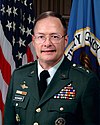 | Lieutenant General Keith B. Alexander (born 1951) | July 2003 | July 2005 | ~2 years, 0 days |
| 42 |
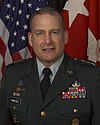 | Lieutenant General John Kimmons | August 2005 | February 2009 | ~3 years, 184 days |
| 43 |
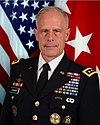 | Lieutenant General Richard P. Zahner | February 2009 | 12 April 2012 | ~3 years, 71 days |
| 44 |
 | Lieutenant General Mary A. Legere | 12 April 2012 | 2016 | ~3 years, 264 days |
| 45 |
 | Lieutenant General Robert P. Ashley Jr. | 2016 | ~3 October 2017 | ~1 year, 275 days |
| 46 |
 | Lieutenant General Scott D. Berrier | 30 January 2018 | 14 September 2020 | 2 years, 228 days |
| 47 |
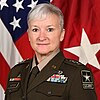 | Lieutenant General Laura A. Potter | 14 September 2020 | 5 January 2024 | 3 years, 113 days |
| 48 |
 | Lieutenant General Anthony R. Hale | 5 January 2024 | Incumbent | 1 year, 11 days |
See also
- Combat Support
- Company Level Intelligence Cell
- G-2 (intelligence)
- Military Intelligence Corps careers
- Military Intelligence Corps Band
- Office of Naval Intelligence
- Sixteenth Air Force
- United States Army Counterintelligence
References
- United States Intelligence Community Official Website Archived 21 October 2007 at the Wayback Machine
- "Intelligence in the Civil War" (PDF). Central Intelligence Agency. Archived from the original (PDF) on 25 December 2013. Retrieved 2014-07-24.
- Theoharis, Athan G., ed. (1999). The FBI: A Comprehensive Reference Guide. Phoenix, OR: The Oryx Press. p. 160. Retrieved 20 May 2011.
- Hammons, Steve (22 April 2015). "The Japanese-American U.S. Army Intelligence Unit that helped win WWII". Defense Language and National Security Education Office. Retrieved 14 March 2020.
- "History of the Presidio of Monterey - Army Language School". Defense Language Institute, Foreign Language Center.
- "Army Birthdays". U.S. Army Center of Military History. Department of the Army. Retrieved 3 September 2015.
- "Military Intelligence, USAR (Obsolete)". The Institute of Heraldry. Office of the Administrative Assistant to the Secretary of the Army.
- "Publications 101" (PDF). usapa.army.mil. Archived from the original (PDF) on 15 October 2004.
- "index2". Hrc.army.mil. 28 October 2009. Retrieved 20 May 2011.
- John Patrick Finnegan, Center of Military History, United States Army, Washington, D. C. (1998). "Military Intelligence". Archived from the original on 22 January 2008. Retrieved 18 February 2008.
{{cite web}}: CS1 maint: multiple names: authors list (link) - Welcome To the Intelligence Center Online Network Archived 17 July 2007 at the Wayback Machine
- MIRC Family Programs Newsletter; Volume 1, Issue 4 Archived 18 April 2015 at the Wayback Machine dated October 2014, last accessed 18 April 2015
- AR 381–10, U.S. Army Intelligence Activities, Department of the Army, dated 3 May 2007, last accessed 7 July 2012
- FM 34-37; Strategic, Departmental, and Operational IEW Operations; Chapter 9, 650TH Military Intelligence Group, last accessed 7 July 2012
Further reading
- McChristian, General Joseph A. (1994) . The Role of Military Intelligence, 1965–1967. Vietnam Studies (reprint ed.). United States Army Center of Military History. CMH Pub 90-19.
- Ruiz, Victor H. (2010). A Knowledge Taxonomy for Army Intelligence Training: An Assessment of the Military Intelligence Basic Officer Leaders Course Using Lundvall's Knowledge Taxonomy. Applied Research Projects. Texas State University Paper 331.
External links
| National intelligence agencies | |
|---|---|
| Foreign intelligence |
|
| Domestic intelligence |
|
| Military intelligence |
|
| Signals intelligence |
|
| Imagery intelligence | |
| Financial intelligence |
|
| Criminal intelligence |
|
| Intelligence community | |
| Intelligence alliances | |
| Defunct agencies | |
| Related topics | |


